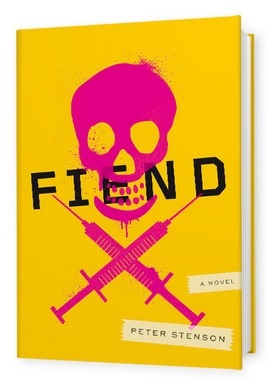Although I’m already half way through Todd Haberkorn reading Fiend: A Novelaloud to me as an Audible audiobook, I ordered the hardback yesterday because I just have to see the text. With what typography did novelist Peter Stenson envision narrator Chase Daniels telling his story of meth addiction and zombies? It’s so beyond my experience, so beyond my wildest dreams and most terrifying nightmares, but seems as real as a documentary. I know I could “Look Inside” on Amazon, but I feel almost desperate to see it for myself. How real is this story?
 Stenson writes so skillfully in present tense with such exquisitely specific and jarring detail that I have no separation. I, too, am spun on meth and watching my giggling zombie mother walk towards me.
Stenson writes so skillfully in present tense with such exquisitely specific and jarring detail that I have no separation. I, too, am spun on meth and watching my giggling zombie mother walk towards me.
I can imagine my former English students, business colleagues, and women friends reading that sentence with dropped jaws (agh, that image!). It’s preposterous that I am reading a zombie book. I am serious to the point of fun-challenged, impatient with popular books, finding them gratuitous, puerile and error-ridden (I quit, groaning, after only a few paragraphs of Fifty Shades of Gray). I will share more about how I discovered Fiend and why I chose to listen to/read it when I finish it. For now, I’ll share that, once I did discover it, I chose it for the reasons I choose all my fiction these days.
The narrator of Fiend, Chase, is self-aware, values his feelings and thoughts, examines his past for insights, and, despite not being at his best physically or psychically, does his best to make choices based on a conscious code of ethics. He’s full monty with life, rarely closing down or backing up. Even though in anguish at times, he strives to find joy in moments and to make meaning of life for himself and others in a f*ed up world, even when the end seems near.
That’s my story, that’s Holden Caulfield’s story, that’s pretty much everyone’s story. We read to see how others handle the striving.
UPDATE:
I finished Fiend and wrote my first post about it here.
The hardback copy of Fiend arrived. I examined Stenson’s typography. He uses no quotation marks. What the characters say aloud and think to themselves flows as one.
. . . . .
Fiend is vividly written and, other than the novel Catcher in the Rye , reminds me of films and a TV series I love with dark or bold humor paired with deep truths: Pulp Fiction, There’s Something About Mary, Glee. To make those Fiend-like, just add meth and zombies.
If Fiend were a movie, I don’t think these ratings would cut (ha!) it – R for “adult themes, adult activity, hard language, intense or persistent violence, sexually-oriented nudity, drug abuse or other elements” or NC-17 for “violence, sex, aberrational behavior, drug abuse or any other element” – because when a zombie’s head explodes from a justifiable shotgun blast, the camera’s going to catch you spitting out a bit of earlobe.

